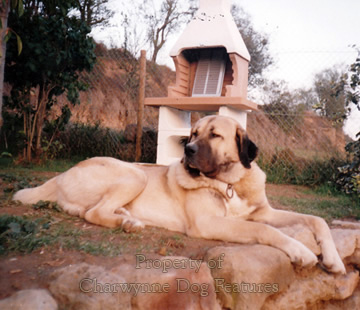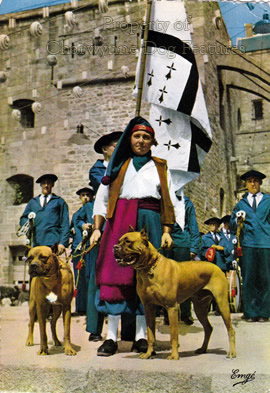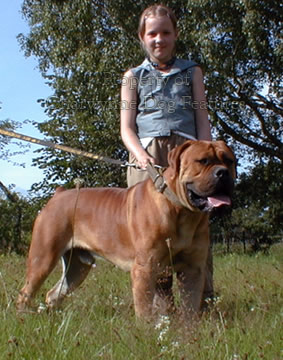344 CANINE GUARDIANS
CANINE GUARDIANS - PROTECTING US AND OURS
by David Hancock
 The range of activities over which dog has provided man with protection for his family and their property is infinite and timeless. From the caves of primitive man to the stately homes of the landed gentry, from the distant steppes to nearby pastures and from Spanish colonists to the servicemen of today, dog has been there in close support. Powerful dogs bred to protect livestock have been utilized from the upland areas of Iberia in the west, right across to Iran and on to the highlands of Eastern Europe, from mountainous Balkan regions in the south and northwards to former Soviet states. Sometimes they are called shepherd dogs, others mountain dogs and a few dubbed 'mastiffs', despite the more precise use of that word in modern times. Their coat colours can vary from solid white to dark-grey and from a rich russet to solid black, often with tan. Many that developed as breeds are no longer used as herd-protectors and their numbers in north-west Europe seriously declined when the use of draught dogs became a victim of the mechanized age. A number of shared features connect these far-flung types: a dense weatherproof jacket, a substantial build, an impressive magnanimity and a strong instinct to guard livestock placed under their supervision. As a group, they would be most accurately described as the flock guardians; in Britain in the distant past they were referred to as 'shepherd's mastiffs', but they were valued all over Europe.
The range of activities over which dog has provided man with protection for his family and their property is infinite and timeless. From the caves of primitive man to the stately homes of the landed gentry, from the distant steppes to nearby pastures and from Spanish colonists to the servicemen of today, dog has been there in close support. Powerful dogs bred to protect livestock have been utilized from the upland areas of Iberia in the west, right across to Iran and on to the highlands of Eastern Europe, from mountainous Balkan regions in the south and northwards to former Soviet states. Sometimes they are called shepherd dogs, others mountain dogs and a few dubbed 'mastiffs', despite the more precise use of that word in modern times. Their coat colours can vary from solid white to dark-grey and from a rich russet to solid black, often with tan. Many that developed as breeds are no longer used as herd-protectors and their numbers in north-west Europe seriously declined when the use of draught dogs became a victim of the mechanized age. A number of shared features connect these far-flung types: a dense weatherproof jacket, a substantial build, an impressive magnanimity and a strong instinct to guard livestock placed under their supervision. As a group, they would be most accurately described as the flock guardians; in Britain in the distant past they were referred to as 'shepherd's mastiffs', but they were valued all over Europe.
.jpg)


Big flock-guarding dogs have been vital for centuries in countries where sheep are pastured in remote mountain areas. Charles Darwin, on a South American tour, noted how such dogs were trained from puppy-hood for their future role. His surprise at finding such dogs is in itself surprising; the mountain pastures of Spain, Portugal, Italy and the Balkans, much nearer home, had featured such dogs for centuries. The flock-master taught the pups how to be suckled by ewes, sleep in a nest of wool and then progress to expect meat at the end of the day at a set location, where the sheep would accompany it. Puppies of the sheep guarding breeds slept with the lambs and sometimes adult bitches allowed lambs to suckle from them. Dog and sheep bonded from such activities, but it was absolutely vital that the whelps lived with the sheep from even before their eyes opened. When flocks of sheep were sold it was common practice to sell the dogs that managed them as well. In this way many sheepdogs went from countries like Britain and Spain to their colonies. This has led to British herding dogs in particular becoming not only the most valued in the world but adapted and developed into native breeds in their new countries. 
What do we want from our guard-dogs? I don't want a savage dog that could harm straying children. I don't want a dog so huge that that alone is supposed to put the fear of God into would-be burglars. Such a dog would eat a lot, sleep a lot and not be very good at negotiating obstacles. I don't want a ceaselessly barking dog, to me a sign of an 'angst-beisser' or fear-biter that misuses body-language alone in an attempt to look menacing. I want a dog full of confidence in its training, one that stands its ground, looks alert and is naturally suspicious of strangers, deterring those contemplating forcing entry by its steadfast demeanour and its imposing presence. A fixed, steady gaze from a formidable-looking, sizeable dog would certainly deter me; I want a silent sentinel, one hinting at controlled fury, disciplined aggression, sheer power and unchallengeable self-assurance.
With burglaries of country properties at an all-time high, with poaching now the province of gangs of professional criminals and with thefts of even antique garden ornaments increasing alarmingly, the need for security in rural residences is greater than ever before. Worried owners wishing to safeguard their property and possessions are usually wise enough to consult reputable security companies before installing an expensive electronic surveillance system. But an expensive guard-dog is usually installed without any consultation at all. And there are no prizes for guessing the breeds likely to be installed in this way or the country of their origin.
annual Kennel Club registration lists of the breeds utilised as guard-dogs in Britain in the last few years, you will quickly notice how dominated these lists are by breeds from Germany. With something like 21,000 in 1998 the German Shepherd Dog leads the guard-dog rankings, to be followed by nearly 10,000 Boxers, some 5,000 Rottweilers then well over 2,000 Dobermanns. If you then look at the numbers registered for the British breeds long associated with guarding duties, there is an appreciable gap, with registrations in 1998 of Airedales (just over 1,000), Mastiffs (under 500), Bullmastiffs (just over 2,000) and Bull Terriers (2,500) being substantially outnumbered by the German breeds. This has not always been so.
At the turn of the century the Bull Terrier was world famous as a companion-guard, admired for its courage, staunchness and loyalty. In the Great War, the Airedale was the preferred breed, as Colonel Richardson, Commandant of the War Dog School then has confirmed: "I have owned and trained at one time or another, nearly every kind of dog suitable for guarding work... but as the result of all my work of years it is my considered judgement that for all round watching and guarding work, the most reliable dog in size and character is the Airedale terrier." Yet today not one Airedale is utilised by the Armed Forces or indeed, by the British police.
All over Europe in the last century, estates and their game were protected by the "night-dogs", big powerful broad-mouthed dogs of the mastiff family; in Italy it was the Neapolitan Mastiff, in France the dogue de Bordeaux, in Britain it was the Bullmastiff, in Denmark it was the Broholmer or mastiff of Broholm Castle. Writing about a gamekeeper's night-dog or Bullmastiff, General Hutchinson in his classic "Dog Breaking" of 1909, used these words:..."the appearance of the formidable-looking animal, and the knowledge of his powers, more effectually prevented egg-stealing than would the best exertions of a dozen watchers. He was the terror of all the idle boys in the neighbourhood. Every lad felt assured that, if once 'Growler' were put upon his footsteps, to a certainty he would be overtaken, knocked down, and detained until the arrival of the keeper." 
I was recently asked, by a farmer-settler in Israel, for my views on the best dog breed to act as a farm-guard or property protector. I told him of the top-class shepherd dogs now being bred by the Thames Valley Police Dog Section here in England, the fine dogs being produced by the Tornabene kennels in Colorado - both impressive working Neapolitan Mastiffs and remarkable 'bandogges' excelling on 'man-work', the outstanding specimens of that French pastoral breed, the Beauceron and the high quality Boerboels being bred by a Belgian kennel, run by Sonia Morgan and her husband Bart Verheyen. I did however advise against choosing a breed but to select the best performing individuals whatever their breed; some kennels produce the best individuals in their chosen breed, far too many use the reputation of a breed to offset the lack of consistency in their particular output. Breeds don't guard property, individual dogs do. After some researches of his own, the Israeli farmer chose to use Boerboels from the Belgian kennel. He will be using them on unfenced land where children often roam and their safety was a factor in his choice. I will follow the progress of his Belgian-bred Boerboels with great interest.
Guard-dogs, whether employed in a rural or an urban setting, have to be firmly trained and have stable, predictable temperaments. Breeds don't have bad temperaments but some breeding lines within a breed do; the temperament of both parents and their parents matters. Biddability or reaction to training matters too; all guard-dogs have to be under control, whether by whistle or voice. We want our guard-dogs to 'persevere' but not ignore or defy their handler; there is an enormous difference between wilful defiance and guaranteed obedience. That difference has to be ascertained in training. I am never impressed, and certainly not deterred, by ceaselessly-barking, ferociously-snarling and superficially-aggressive guard-dogs; such mannerisms are so often a sign of an 'angst-beisser' or 'fear-biter' - a dog motivated by anxiety not protective instincts. An effective guard-dog has to be motivated by defensive determination rooted in imbedded training and over-riding loyalty to its own master. My Bullmastiffs very rarely barked, but a black-masked, utterly-determined stare of suspicion, backed by their imposing size, made them natural guards. This alone can be so reassuring.